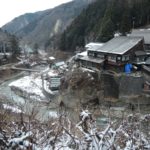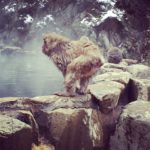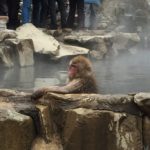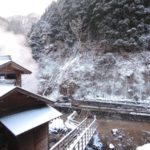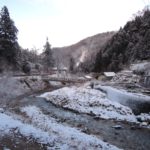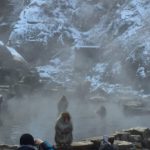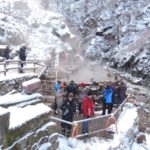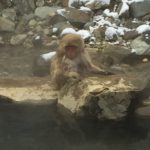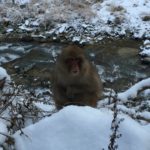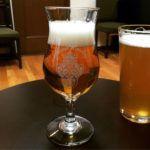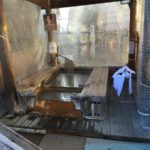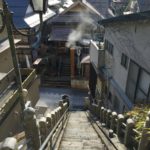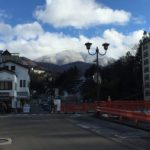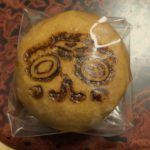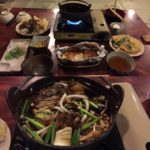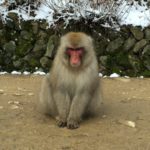oyaki おやき: a style of dumplings from Nagano prefecture
I went to a workshop organized by a company called “Table Watch”— to learn how to make dumplings from an Okinawan obaachan, Yaka-san. Oyaki is a traditional Nagano food.
The Book cafe&hall Yukaruhi is located on the 3rd floor of the Yaka Building in Naha (Yaka-san’s family owns the building, hence the name Yaka Building). There is a big sign in front that says “Vegan OK!” Nice. Inside, it is part crafts workshop, part cafe, part music hall… there are many aspects to this place.
Anyway, I registered with Ayako-san the workshop coordinator for Table Watch, received my name tag and hair net, along with the other attendees (both Japanese and American).
Yaka-san started us off with explaining about oyaki and showing us pictures of different fillings, as well as the more traditional cooking methods in ashes. Then she sang us a special song she wrote about oyaki for the class. It was awesome, and explained the oyaki-making process. She was born and raised in Okinawa, but when she got married moved with her husband to Nagano. She recently returned to open the cafe here in Okinawa.
Then we got to start making our own dough. Just flour, lukewarm water, baking powder, and sugar, mixed and kneaded until the texture was “like a baby’s cheek” (赤ちゃんのほっぺ!). Next the dough has to rest.
For the fillings, we used 3 different types: nozawana (pickled greens) with spicy red pepper added, shiri-shiri kabocha (grated pumpkin sautéed with red miso), and zucchini slices sandwiched with sweet light miso. All 3 were delicious. She taught us the basic techniques for the fillings and let us sample.
Next we divided out the dough, and learned how to make the shape… it is kinda like when you stretch out a pizza dough except you want to keep the center part fat and make it thin around the edges. Add the filling and then wrap the edges up (similar technique to making nikuman or other Chinese dumplings). From here they were flipped over (so pinched side on the bottom), put onto a small square of parchment paper, and steamed for about 10-15 minutes. You can also fry and then steam or just bake if you so desire.
Once we were finished, we got to relax and eat our oyaki with some black bean tea and sobagaki. Sobagaki is another regional dish made form soba flour mixed with hot water and stirred in a bowl, until it becomes a mashed-potato-like dough ball. The dough is then torn into bite-sized pieces and dipped in a sauce, like shoyu or spicy pepper dressing. It kinda reminded me a little of poi, a little sticky and chewy. Everything was delicious and I really enjoyed myself. Yaka-san was so cute and friendly.
Anyway, the cafe is open during the day Thursday through Monday, so be sure to stop in for a delicious oyaki snack sometime! She also serves some meat things and cafe drinks as well as the vegan oyaki. I also recommend trying a workshop organized by the Table Watch company!
pictures on imgur: https://imgur.com/a/KKzT6
address for cafe, open Thurs-Mon 11am-7pm: https://goo.gl/maps/Rgx4vu8bpL72
Oyaki recipe: this is mostly just for the skin, the filling is sort of up to you but I include some ideas!
Makes 10 oyaki skins:
-300 g of Chuurikiko 中力粉: medium strength flour used for udon making (about 9% protein strength)
-1 teaspoon baking powder
-2.5 teaspoon granulated sugar
-180 cc warm water
Mix together the ingredients with chopsticks until it becomes more dough-like then knead like bread, with a little extra flour to keep from sticking, until springy (Japanese like to say “until it is the texture of a baby cheek”). Let it rest for awhile, at least 30 minutes so it gets elasticity.
Prepare your filling, whatever you want (seriously anything), just can’t be too wet as excess water causes the oyaki skin to crack as it cooks!
In our workshop we had 3 different fillings: 1) nozawana 野沢菜, a type of pickled greens from Nagano which is easy to find in Japan grocery stores… spinach or something could also be good, just be sure to squeeze the water before filling the dumpling skin with the cooked spinach. 2) We also used shredded kabocha sautéed with red miso. 3) zucchini cut in 2cm round, then sliced not quite in a half, stuffed with sweet light miso like a sandwich. **Basically, anything goes, just nothing with too much water.
Divide the dough into pieces, then shape into a ball shape. Stretch it out slowly from the sides kinda like when making a pizza dough, keeping the middle a little fat (keeps the skin from breaking while steaming), and thinner on the sides. In the middle add your filling and then wrap the sides up like a little package, pinching in the middle to close it. Yaka-san said don’t worry too much about the shape of the oyaki, if it is rounder or flatter– it shows your personality, apparently. Put them onto a small piece of parchment paper in a steamer basket (if you are steaming them).
Steam 10-15 minutes. OR pan-fry for 3 minutes each side and then steam OR just bake them. In the workshop we steamed them, and this would be the healthiest option.
